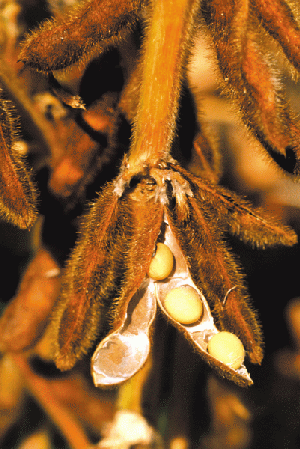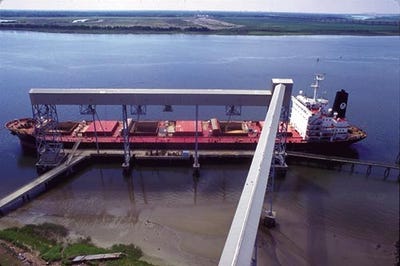
Looking ahead: soybeans will drive commodity markets
A key question in commodity markets, says John Anderson, American Farm Bureau Federation deputy chief economist, is, “What’s soybean acreage going to be in 2014?" But, he says, the even more relevant question is, "How many acres will corn give up, and to what extent will Corn Belt farmers shift away from corn and back to beans?"

Lower corn prices from this year’s huge crop are expected to encourage acreage switching to soybeans in 2014 and, says John Anderson, “It looks like soybeans will be driving the train in terms of what’s going on in the markets for a year or year and a half.
“The corn supply situation will get a little less supportive, and soybeans will continue to be where support in the market is,” he said at the annual meeting of the Mississippi Farm Bureau Federation.
Anderson, who is deputy chief economist for the American Farm Bureau Federation in Washington, says, “I think that’s the most realistic scenario — but there are a lot of possibilities and a lot of analysts speculating about the outlook.”
Ag news delivered daily to your inbox: Subscribe to Delta Farm Press Daily.
A key question, he says, is “What’s soybean acreage going to be next year? But, the even more relevant question is, how many acres will corn give up? To what extent will Corn Belt farmers shift away from corn and back to beans?
“There has been a lot of corn after corn, and even some corn after corn after corn. Is the situation now such that a lot of these farmers will shift back to beans? And how big an acreage shift do we need?

With lower corn prices, how many Corn Belt acres will switch to soybeans in 2014?
“I think we do need a pretty substantial acreage shift to relieve the building supply pressure on the corn market. If we want to see support return for corn prices, there needs to be a move away from corn acres.
“How big will that move be? I personally don’t think it’ll be very big. With some of the investments farmers have made in on-farm storage, and particularly with some of the really big land rents that have been locked in, it’s going to be tough for them to move away from that high revenue crop.”
As a hypothetical example, Anderson says, “Let’s say we move 3 million acres out of corn, compared to what we planted this year, and we add another couple of million acres of beans (which would be a big number), and add a little acreage to wheat, for a total of 229 million acres of corn, beans, and wheat.
SEE ALSO: Matt Miles shatters Arkansas soybean yield record
“What would that do to the supply situation? With those kinds of acreage changes, we could see corn stocks-to-use go up another 1.5 percent, even with some growth in use. We’d see beans essentially holding steady, or increasing a little bit, creating room for a little more use.
“These are certainly doable situations in terms of acres. But the supply situation wouldn’t change a lot, and arguably could get a little less supportive than it is now, particularly for corn. There is room for this kind of supply situation to get at least a little more bearish over the next year.
“The big question,” Anderson says: “Will corn drop by as much as 3 million acres? If it hadn’t been for the early season problems and prevented plantings this year, we probably would’ve had 97 million acres. Could we go from 97 million planned acres for 2013 to 92 million in 2014? That’s a big change, and given the friction in the market, I think it’s a bigger change than we’ll see.
“It’s not an unrealistic example, but I’d be surprised if corn drops that much and beans go up that much.”
Soybeans in driver's seat
Soybeans have “kinda been following the corn market for a long time,” Anderson says, and “we’ve all got into a habit of looking at what’s going on with corn, and everything being driven by corn.

Soybean supplies remain relatively tight, says American Farm Bureau Federation Economist John Anderson.
“But with commodity markets in transition, I think we’re moving to a point where soybeans will be in the driver’s seat for the next several months — maybe even the next year.
“While the corn supply situation has loosened up a lot with this year’s big crop, we’re still looking at a pretty tight soybean market, with a stocks-to-use ratio below 5 percent at the end of last marketing year, and expected to go to only 5 percent at the end of the current marketing year. That’s still a pretty tight supply situation.”
READ HOW 100 bushel soybean barrier was broken by Arkansan Nelson Crow
The U.S. always lives with a tighter soybean situation, he says, because of the large South American production that comes off in in the middle of the year.
“Even so, on the supply side, this market still has a lot of support for price.”
Looking at USDA’s usage figures, Anderson says, “We don’t see anything really dramatic for domestic crush or exports. There’s certainly upside potential in both of those sectors, but we’re constrained a bit by crop availability, and that’s a very supportive situation for price. To the extent there is support for grain prices now, it’s coming from the soybean market.”
Total use is projected at 3.2 billion bushels, he says. “We were using a lot more than that as recently as 2009/2010, so clearly there’s room for that number to grow somewhat, and that will continue to support the market for the next several months.
“Everyone is watching really closely what’s going on in South America — that’s the market’s focus right now. It’s pretty dramatic how South America has changed things. The U.S. does not carry the world’s stocks any more — it’s Brazil and Argentina.
“They’re carrying a lot more of the world’s stocks than we are. But Brazil continues to have issues with infrastructure, and Argentina with its exchange rate, and these are serious impediments to their international trade, which certainly helps us.”
The South American soybean crop this year is large, Anderson says, but “it’s too early to tell how it’s going to work out, and for now that uncertainty is supportive for U.S. prices.”
But he says, there is a potential downside for farmers with unsold soybeans. “You have to be concerned that if we get to February and it looks like South America is going to have a fantastic crop, with an above-trendline yield, we’d see support in the market start to erode.
“Right now, we’re supported by tight supplies, but that could come undone as we see more about what’s going to happen in South America. Be aware of this — and recognize it as a potential downside in your marketing plan.”
South America infrastructure
How long will it take for South America to get on top of its infrastructure problems, Anderson was asked.
“Nobody can say with any certainty, but I think we have to assume, from the standpoint of our planning and strategic thinking, that they’ll get their problems worked out start making the capital investments needed for their infrastructure to run fairly smoothly.

While U.S. infrastructure for crop exports is well-developed, much work remains to be done in Brazil and Argentina.
“Brazil is a much bigger country than the U.S., and their infrastructure situation is never going to be the same as ours. They’ve got a lot of potential for inland waterways, but they’re not where they’d like to be, whereas we have an almost ideal situation in our ability to develop infrastructure. Maybe we’re not managing ours as well as we ought to be, or making the longer term investments in maintenance that we should, but we have a situation that’s better than theirs. [It costs Brazilian farmers, on average, almost twice as much to ship 1 metric ton of soy to Shanghai as it does an American farmer, according to USDA.]
“They have a lot of potential though, and I think we have to assume at some point they’ll start getting the most out of it. But that’s probably at least 10 years away.
SEE ALSO: Mississippi soybean producers launch aquifer initiative
“I’ve got less confidence in Argentina; their situation isn’t so much an infrastructure issue as it is a policy issue, and I think they’re going to continue to be handicapped by that.
“I think the longer-term outlook is better for Brazil than Argentina. But from a defensive standpoint, I think we need to assume at some point they’ll start making good decisions and good investments and that they will start to catch up.
“They may not — but if we assume they won’t, we can get ourselves in trouble.”
About the Author(s)
You May Also Like



